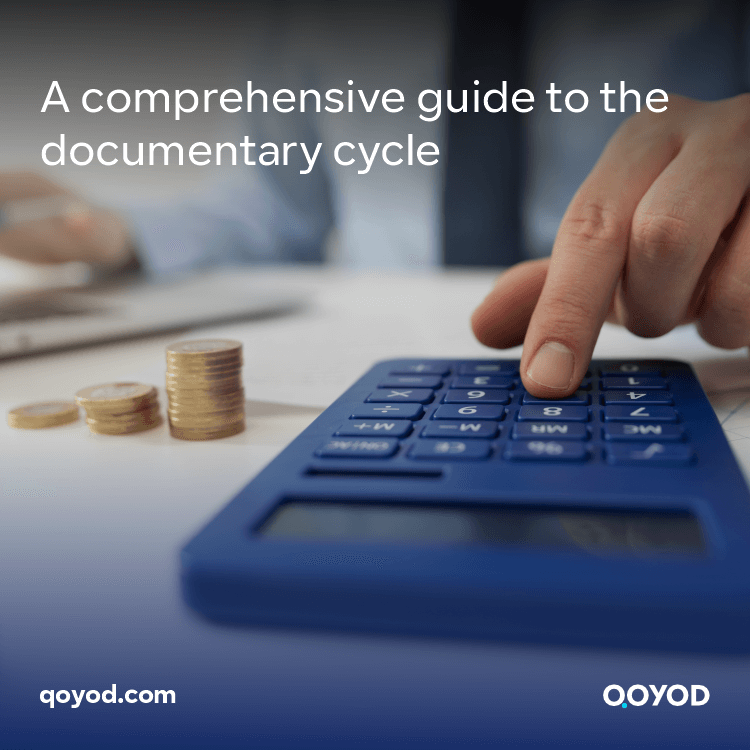- The documentary cycle: a comprehensive guide to it
Have you ever wondered about the hidden power behind billing papers? Did you know that there is a secret cycle that manipulates these papers to become more than just ordinary financial documents? It is what is known as a documentary cycle, and it is a masterpiece that combines creativity and impact. In the documentary cycle, bills turn into magical tools that tell exciting stories. So follow along with us to learn more about this cycle.
What is a documentary cycle?
The documentary cycle can be defined as a vital process that contributes to the organization and management of documents within institutions and companies and shapes the way documents follow during their circulation and movement from one place to another. It includes a set of procedures and vessels that ensure a smooth and effective workflow. One of the main aspects of the documentary cycle is verifying the accuracy of documents and the validity of the data contained therein.
This is done by carefully examining the information and numbers included in the documents and ensuring that they are correct and consistent with reality. It is worth noting that this procedure is necessary to ensure that the documents reflect the facts and contribute to the correct workflow.
Sections of the documentary cycle
When talking about the documentary cycle, we find that it consists of several sections that work together to ensure the smooth and accurate flow of information and financial documents, the most important of which are the following:
Cash receipts
Cash receipts are one of the sections of the documentary cycle and include all operations related to collecting money from customers and recording them, whether cash sales or collecting payments via checks or bank transfers.
Forward purchases
It represents purchases for which payment is delayed after receiving materials or services from suppliers. It is worth noting that these purchases are recorded in the suppliers’ credit accounts, and the payment processes and related financial follow-up are followed.
Cash expenses
Includes all expenses paid in cash, such as salary and wages costs, maintenance and repair expenses, in addition to advertising and marketing costs, and other general expenses.
Cash purchases
Refers to purchases that are paid for in cash, such as: purchasing raw materials or office supplies, and these transactions are recorded; To report expenses and manage inventory.
Forward sales
It expresses sales operations in which the payment period is extended to customers after the delivery of products or services, records these sales in customers’ receivable accounts, and follows up on collection operations and financial follow-up related to them.
Accounting entries
Accounting entries are essential in the process of recording and documenting financial transactions and include transferring data from the original documents to the main accounting records. This ensures the accuracy and reliability of financial information.
Warehouses
It includes inventory management and control processes, including recording and counting incoming and outgoing materials, controlling available quantities, and preparing relevant periodic reports.
What are the stages of the documentary cycle?
The steps of the documentary cycle consist of several important stages that contribute to organizing documents and preparing the necessary financial information for companies and institutions. If you are wondering: How is a complete documentary cycle done?
Recording in the journal
The documentary cycle begins with recording daily financial transactions in a journal, and important information and numbers, such as invoices, payments, purchases, and sales, are recorded in this notebook.
Posting to the ledger
After recording transactions in the journal, these transactions are posted to the ledger, which contains various accounts representing assets, liabilities, capital, revenues, and expenses. The transactions are then posted to the appropriate accounts in the ledger.
Preparing the trial balance before settlement
The trial balance is prepared before settlement. To evaluate the company’s financial position, review the outstanding balance and active balance in various accounts; To ensure their accuracy and conformity with recorded transactions.
Inventory adjustments
This stage includes auditing and verifying the accuracy of data and numbers related to the inventory and comparing the physical balances of the inventory with the balances recorded in the accounting records. To ensure that there are no unjustified differences.
Preparing the trial balance before settlement
The trial balance is prepared before settlement. To evaluate the company’s financial position, review the outstanding balance and active balance in various accounts; To ensure their accuracy and conformity with recorded transactions.
Inventory adjustments
This stage includes auditing and verifying the accuracy of data and numbers related to the inventory and comparing the physical balances of the inventory with the balances recorded in the accounting records. To ensure that there are no unjustified differences.
The importance of the documentary cycle
The documentary cycle is one of the basic factors in the management of companies and institutions and is of great importance in ensuring that financial and administrative operations proceed in a sound and transparent manner. The following are the most important points that highlight its importance:
Providing the greatest evidence
Accounting documents and records are the main evidence that proves the existence of financial operations and their details. It provides objective and reliable data that can be verified by government agencies and other external parties.
Legal recognition
In the event that transactions are not recorded with documents, it is likely that they will not be recognized among individuals, companies, or even legally. Therefore, the documentary cycle plays a crucial role in confirming the validity of operations and transactions and maintaining the integrity of the institution from a legal standpoint.
Preserving financial rights
A sound documentary cycle contributes to protecting the rights of project owners, citizens, and parties dealing with the company financially when there are accurate and reliable records. Ensures the accounting of financial operations and transactions; Thus, fraud and financial manipulation can be avoided.
Enhancing cohesion and communication
It contributes to enhancing cohesion and communication between the various divisions and departments in the company when it documents and provides financial and administrative documents properly. Teams can collaborate and coordinate better, which enhances work efficiency and achieves common goals.
Make rational decisions.
The documentary cycle enhances the ability of company managers to make rational decisions when financial and administrative information is reliable and readily available. Managers can make informed decisions based on careful analysis of available data.
What is the difference between the documentary cycle and the accounting cycle?
The documentary cycle and the accounting cycle are two interconnected parts of the accounting process, but they have different goals and functions. The following are the most prominent points that explain the difference between them:
Documentary cycle
- The documentary cycle is the basic vessel for recording financial transactions.
- All documents and financial documents are documented and recorded in this cycle.
- It focuses on documenting and recording financial information accurately and systematically and includes: Financial documents: invoices, payments, purchases, sales, etc.
- The documentary cycle is used to verify the validity of information and financial transactions and to ensure their completeness and accuracy.
- This cycle serves as a documentation tool and proof of financial transactions.
Accounting Cycle
- The accounting cycle includes all accounting operations carried out to prepare financial information and accounting reports.
- The accountant is responsible for implementing the accounting cycle operations and managing them sequentially and systematically.
- These processes include recording journal entries, preparing the ledger, reconciliation entries, trial balance, creating financial statements, and also closing entries.
- The accounting cycle aims to transform the financial information recorded in the documentary cycle into important accounting reports, such as the income statement and financial position.
- These reports help evaluate the company’s performance and make the right financial decisions.
Conclusion
The documentary cycle is a major process in accounting that ensures that financial information is recorded and documented accurately and reliably. This process is essential to ensuring that financial operations are conducted correctly and effectively within the organization. It enables management to understand and analyze financial data and make the right strategic decisions. In addition, it helps enhance coordination and cooperation between different departments and facilitates access to accounting documents between departments within the company. As an essential tool in the field of accounting, it should be the focus of attention for companies. and institutions, if properly implemented, it can make a big difference in the effectiveness of financial operations, achieving transparency and reliability in financial reporting. Therefore, companies must invest in building and improving the documentary cycle and provide training and continuous support to the employees concerned with it.
If you want to enhance the quality and reliability of financial management in your organization, the documentary cycle is the key, and do not forget to use an accounting program such as Qoyod as a certified partner. It also provides all its customers with electronic invoice systems as well as point-of-sale systems, stores, customers, and so on.
After knowing what the documentary cycle is and its sections, try Qoyod now for free for 14 days and make it an integral part of your life. It is an integrated accounting program.
Join our inspiring community! Subscribe to our LinkedIn page and Twitter to be the first to know about the latest articles and updates. An opportunity for learning and development in the world of accounting and finance. Don’t miss out, join us today!




